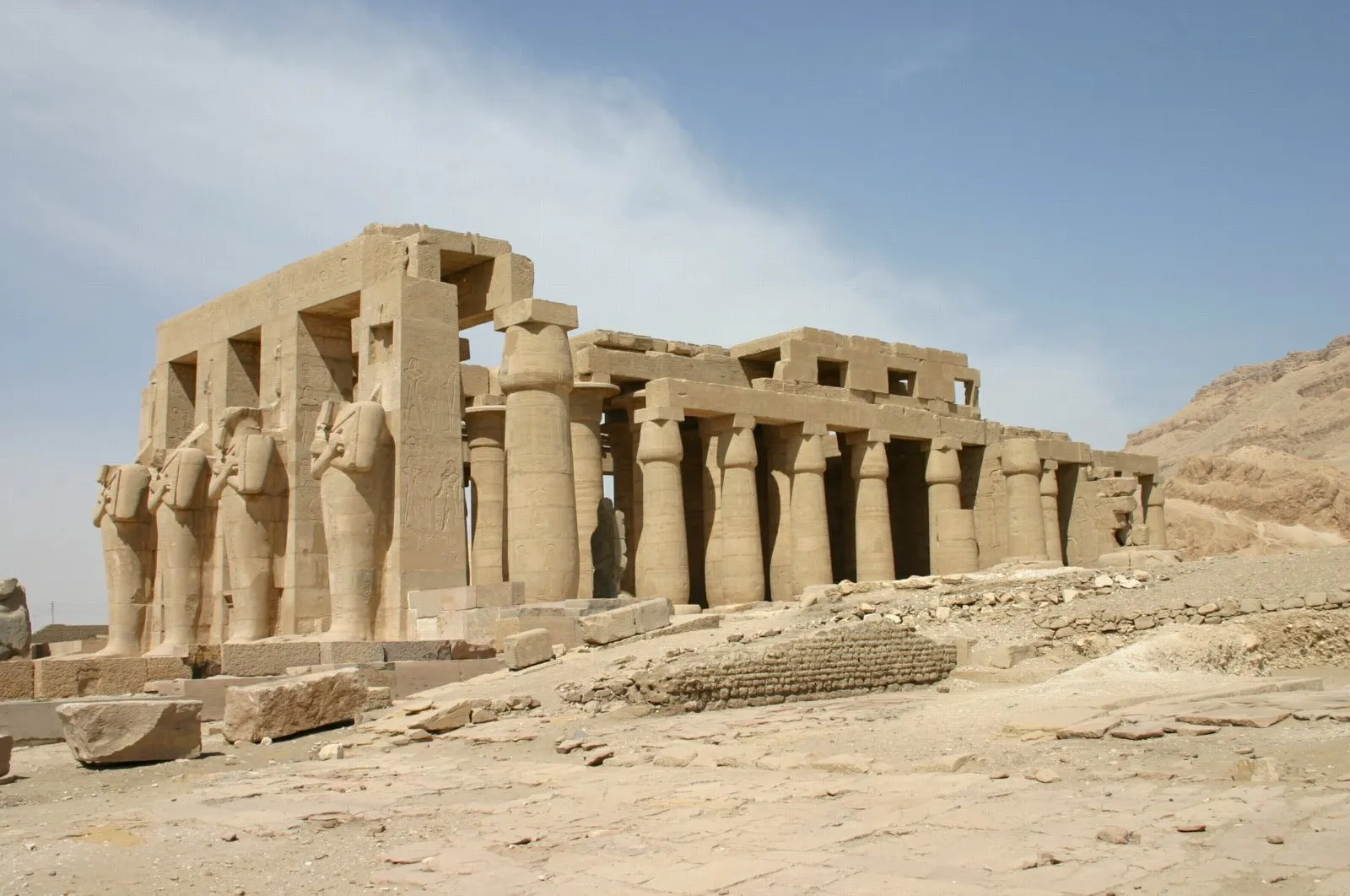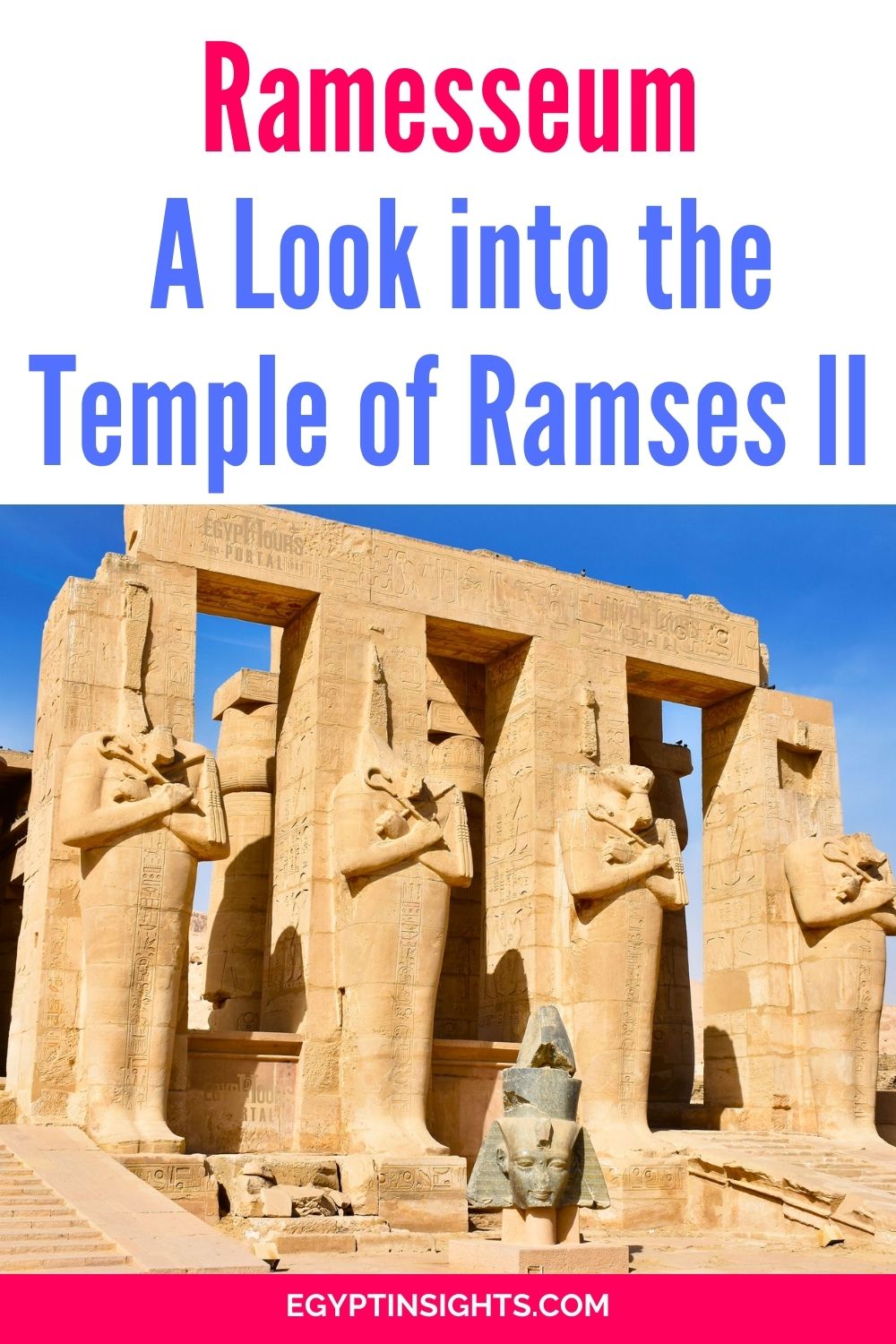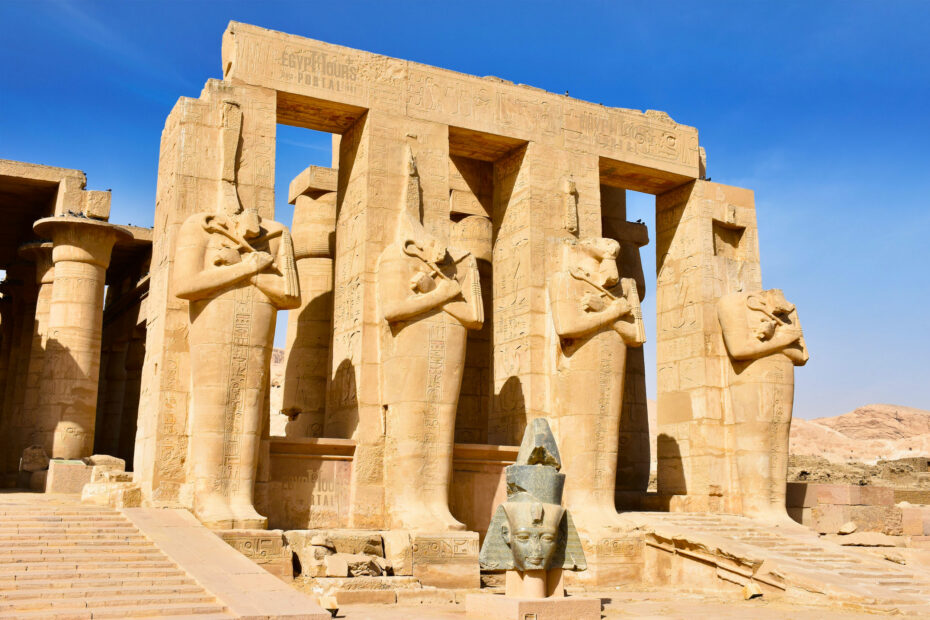The Ramesseum is a memorial temple in the Theban Necropolis of Upper Egypt, on the west bank of the Nile River, opposite the modern city of Luxor. It was built by Pharaoh Ramesses II, also known as “Ramesses the Great,” during his 67-year reign in the 13th century BC.
The temple was dedicated to the god Amon and the deceased king, and it remains one of the largest and most impressive monuments of ancient Egypt.
The Ramesseum is famous for its 57-foot seated statue of Ramesses II, although only its fragments remain. The temple walls are decorated with reliefs, including scenes of the pharaoh’s military campaigns and religious rituals.
The temple was also the site of the annual Opet Festival, which celebrated the union of the god Amun with his wife, Mut, and their son, Khonsu.
The Ramesseum is a popular tourist attraction today, drawing visitors worldwide to marvel at its impressive architecture and rich history.
Its massive courtyard, intricate carvings, and hieroglyphs tell stories of gods, kings, and the afterlife, providing a fascinating glimpse into Egypt’s ancient culture.

Historical Context
King Ramesses II
King Ramesses II, also known as Ramesses the Great, was one of the most influential and successful pharaohs of the New Kingdom era in Ancient Egypt. He ruled from 1279 to 1213 BC and is known for his military campaigns, notably the Battle of Kadesh against the Hittites.
Ramesses II was a prolific builder, commissioning many grandiose projects, such as the Ramesseum, a mortuary temple dedicated to himself and the god Amun.
The temple was built on the west bank of the Nile River at Ancient Thebes, the capital of Egypt, during the New Kingdom era.
The New Kingdom Era
The New Kingdom era in Ancient Egypt was a time of great prosperity and power. It lasted from around 1550 to 1070 BC and was characterized by solid pharaohs, military conquests, and grand building projects.
During this time, Ancient Thebes was Egypt’s political and religious capital, and it was home to many magnificent temples and tombs, including the Ramesseum. The era was also marked by conflict, particularly with the Hittites, a mighty empire in modern-day Turkey.
Architectural Design
The Ramesseum is a mortuary temple that Pharaoh Ramesses II built in the 13th century BC. It is renowned for its impressive design and architecture, which adhere to the standard canons of New Kingdom temple architecture. The temple measures 220 feet by 600 feet and features a main entrance adorned with intricate battle scenes.
Hypostyle Hall and Columns
The Hypostyle Hall is a large hall with a flat roof supported by rows of columns. The Ramesseum has a Hypostyle Hall divided into three aisles by rows of columns. The columns are decorated with intricate carvings of hieroglyphs and images of gods and goddesses.
Courtyards and Pylons
The Ramesseum has two courtyards surrounded by walls and pylons. The first courtyard is the largest and is surrounded by a wall with two pylons.
The second courtyard is smaller and is surrounded by a wall with one pylon. The towers are decorated with intricate carvings of battle scenes and images of gods and goddesses.
Sanctuary and Chapels
The sanctuary is the most sacred part of the temple and is where the statue of the god or goddess is kept. The Ramesseum has a sanctuary at the back of the temple, surrounded by several chapels dedicated to various gods and goddesses.
Egyptian temple architecture often based its design on the ancient Egyptians’ mythological beliefs.
The Ramesseum is a testament to the grandeur and power of the ancient Egyptian civilization, and its impressive design and architecture continue to inspire awe and wonder in visitors today.
Cultural Significance
The Ramesseum temple is a historical and cultural treasure trove. Its hieroglyphic inscriptions and reliefs offer valuable insights into ancient Egyptian culture, from religious practices to military conquests. The following subsections highlight the cultural significance of the Ramesseum temple.
Religious Practices
The Ramesseum temple was dedicated to Amon, one of the most important gods in ancient Egyptian religion, and the deceased king Ramses II.
The temple’s walls are decorated with reliefs, including scenes of worship, rituals, and ceremonies. These reliefs provide a glimpse into ancient Egypt’s religious practices.
Artistic Contributions
The Ramesseum temple is a true marvel of ancient Egyptian architecture and culture. Built over 3,000 years ago by Pharaoh Ramesses II, it was one of Egypt’s most impressive and critical religious centers.
The temple’s massive courtyard and intricate carvings and hieroglyphs showcase the artistic contributions of ancient Egyptian artists.
Ramesseum as a UNESCO Site
The Ramesseum temple is a UNESCO World Heritage Site. Its significance is due largely to the time and manner in which modern archaeologists rediscovered it.
The temple provides a unique insight into ancient Egyptian culture and architecture, making it an important site for historians, archaeologists, and tourists.
The Ramesseum Complex
The Ramesseum Complex is a mortuary temple located on the west bank of the Nile River in Upper Egypt.
It was built during the reign of Pharaoh Ramesses II and is dedicated to the god Amon and the deceased king. The complex is an impressive 210 by 178 meters and follows the cannons of Egyptian temple design.
Mortuary Temple Function
The Ramesseum Complex was built as a funerary temple for Pharaoh Ramesses II. It was meant to serve as a place of worship for the pharaoh’s soul after his death and to celebrate his life and accomplishments.
Statues and Colossi
The Ramesseum Complex is famous for its colossal statue of Ramses II, about 57 feet tall. The statue was carved from a single stone block and meant to represent the pharaoh as a god. The complex also contains many statues and colossi of Ramses II and other gods and goddesses.
Granaries and Storerooms
The Ramesseum Complex also contains granaries and storerooms for storing food and other supplies. These rooms were vital because they ensured the temple had enough resources to support the pharaoh’s soul in the afterlife.
Excavation and Research
Champollion’s Discoveries
Jean-Francois Champollion, the French scholar who deciphered the hieroglyphs in the 19th century, was among the first to explore the Ramesseum.
He discovered many reliefs and carvings depicting Pharaoh Ramesses II’s life and military campaigns. Champollion’s work helped scholars understand the significance of the Ramesseum in ancient Egypt.
Ongoing Archaeological Work
Archaeologists have been excavating the Ramesseum for over a century, and ongoing work continues to reveal new insights into the temple’s history. Recent discoveries include stone blocks that were once part of the temple’s walls and columns and fragments of inscriptions that shed light on the temple’s construction and renovation.
The Ramesseum has also been the site of several important finds, including the Tomb of Ozymandias and the Colossus of Ramesses II.
These discoveries have provided valuable information about the temple’s construction and role in ancient Egyptian society.
Archaeologists have used various techniques to study the Ramesseum, including ground-penetrating radar and laser scanning. These methods have helped researchers map the temple’s layout and identify areas of interest for further excavation.
Cultural References
Shelley’s ‘Ozymandias’
The Ramesseum, also known as the mortuary temple of Ramses II, is famous for its role in Percy Bysshe Shelley’s sonnet, ‘Ozymandias.’ The poem describes the crumbling ruins of a once-great monument and the arrogance of the king who built it.
The statue of Ramses II at the Ramesseum, now in fragments, inspired Shelley’s poem. The sonnet is a powerful commentary on the fleeting nature of power and the inevitability of decline.
Ramesseum in Modern Media
The Ramesseum has also been featured in modern media. The temple was used as a location in the 1960 film The Ten Commandments, which tells the story of Moses and the Exodus.
It has also been featured in video games such as Assassin’s Creed Origins and Civilization VI. The temple’s impressive architecture and rich history inspire artists and writers today.
Conservation and Tourism
Preservation Efforts
The Ramesseum temple, located on the West Bank of the Nile, is a significant historical and cultural site that attracts visitors worldwide.
The Egyptian government has implemented several preservation efforts to ensure the temple remains well-preserved for future generations.
One of the primary preservation efforts is the conservation of architectural features, which involves repairing and restoring damaged parts of the temple.
This effort aims to maintain the temple’s structural integrity and prevent further deterioration due to weathering and erosion.
Another critical effort is to maintain the temple’s historical and cultural significance. This involves protecting the temple’s artifacts, such as offerings, from theft or damage.
Additionally, the temple’s inscriptions and reliefs are being documented and studied to understand ancient Egyptian culture and religion better.
Visitor Experience
The Ramesseum temple is open to the public, and visitors can enter through the main entrance. The temple’s interior features several chambers and halls with intricate carvings and inscriptions.
Visitors can also learn about the temple’s history and significance through guided tours and informational plaques. The temple’s location on the West Bank of the Nile provides a stunning view of the surrounding landscape and the river.
The temple also hosts the Festival of Min, an ancient Egyptian festival that celebrates the god of fertility and harvest. Visitors can witness traditional dances and performances during this festival and learn about ancient Egyptian culture.

Frequently Asked Questions
What was the purpose of the Ramesseum?
The Ramesseum was a temple complex built by Pharaoh Ramesses II in the 13th century BCE to honor the god Amun and serve as a monument to the pharaoh’s greatness and achievements.
The temple was designed as a place of worship where priests could perform rituals and ceremonies to honor the gods and ask for their blessings.
What are some significant architectural features of the Ramesseum?
The Ramesseum is known for its impressive architectural features, including a massive hypostyle hall with 48 columns, a courtyard with a giant statue of Ramesses II, and walls covered in intricate carvings and hieroglyphs. The temple was built using sandstone and limestone and was decorated with colorful paintings and reliefs.
How has the Ramesseum survived throughout history?
Despite being damaged by earthquakes, floods, and looting over the centuries, the Ramesseum has survived as one of the most impressive examples of ancient Egyptian architecture. Restoration work has helped preserve the temple and remains a popular tourist attraction.
What artifacts have been discovered at the Ramesseum site?
Archaeologists have uncovered several vital artifacts at the Ramesseum, including statues, reliefs, and inscriptions.
One of the most notable discoveries was a papyrus scroll containing the text of the epic poem “The Story of Sinuhe.” Other artifacts include pottery, jewelry, and tools used by the temple workers.
How did the Ramesseum influence ancient Egyptian culture?
The Ramesseum was an essential symbol of the pharaohs’ power and wealth, and it played a significant role in shaping ancient Egyptian culture.
The temple’s intricate carvings and hieroglyphs provided a glimpse into the beliefs and practices of the ancient Egyptians, and its grandeur and scale inspired awe and reverence among the people.
What are the notable inscriptions found in the Ramesseum?
One of the most famous inscriptions at the Ramesseum is the “Ode to the Nile,” a hymn to the river considered sacred by the ancient Egyptians.
Other inscriptions describe the pharaoh’s military campaigns and conquests and depict scenes of the gods and goddesses worshipped at the temple.
